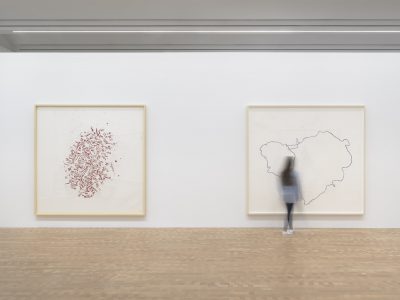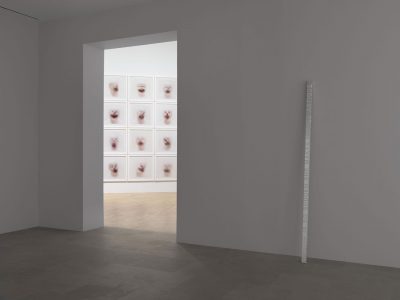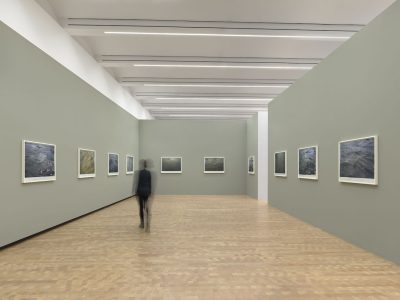Every trip to the earthy yet elegant Glenstone Museum in Potomac is thought-provoking. But the newly installed–by the artist herself–Roni Horn exhibit creates a multitude of conversations as delightful as they are profound. Room after room presents four decades of sculpture, photographs and mixed media pieces.
The show, which opened March 9, will be on view until Jan. 28, 2018–ample time to visit, revisit, recommend and bring friends. Last week’s press preview offered an opportunity to walk the show with Emily Wei Rales–collector, director and chief curator.

Rales is at home with important art like Horn’s–literally. She and husband Mitchell Rales live right across the pond from the museum. Her intimate relationship with Horn’s art and insights from the artist herself debunk the myth that modern art is austere. The Horn show skews warm and whimsical.
Horn and Glenstone seem meant to be. Many of the show’s 30-plus pieces yearn for natural light and Glenstone is one of the few venues that can provide that. In fact, the abundance of light at Glenstone is a hallmark feature of the museum. Another involves metrics. The Rales insist on offering museum-goers an intimate experience with their art. All visitors are cordially greeted at the Glen Road gate, guided down the driveway and, once inside, each has 35 square feet of space. Capping reservations gives guests space to circulate and reflect.
Nowhere is this more useful than in the first room of the Horn exhibit where visitors encounter a five-ton record-setting block of solid cast pink glass. “Pink Tons” (2008-2011) took a few attempts to get right and eight months to cool. It appears to “glow from below,” Rales pointed out. A collection of four solid aluminum and cast plastic sculptural messages surround “Pink Tons.” These comprise the “White Dickinson” series, an homage to Emily Dickinson whose poetry influenced Horn’s work.

“Gold Field” (1982/2003), made exclusively of annealed pure gold, commands the adjacent room. “It makes me nervous—like it’s going to blow away,” one viewer said, to which Rales replied, “It’s heavier than you think.” She revealed that the large sheet is comprised of several small pieces that are flattened and welded together. “Gold Field,” which debuted at MOCA in Los Angeles, explores Horn’s “fascination with the myths associated with gold,” like those in parables and storybooks, Rales said.
“Cabinet of” (2001-2002) occupies the next space. Thirty-six C-prints convey 36 emotions. The subject, a clown “pulled right out of the Yellow Pages,” Rales said, sat for the artist who took two-second exposures of his various expressions.
Much larger works hang together as the “Or” and “Else” series. These colossal works feature almost microscopic words and numbers that the viewer is left to decipher. Some words are playful—“cookie,” “hay,” “pout” and “parrot”—and others are…unsuitable for all audiences. (Children younger than 12 are not admitted.) These works deploy powdered pigment, graphite, charcoal, colored pencil and varnish on paper using a splicing technique that evokes, “genetic recombination or mapping,” said Rales. These pieces can be experienced one way from afar and another up-close, and “point to Horn’s love for words and word play,” Rales said.
Playful words continue with the “Hack Wit” series (2014), “Remembered Words” (2012-2013), “Bending Moments” (1984), Sometimes Dead” (1993) and “Does a Bear Shit in the Woods?” (2011) Each uses very carefully selected choices of paper, as revealed in the accompanying text on the walls.

Horn repeatedly presents side-by-side images. “Bird” (1998-2008) and “a.k.a” (2008-2009) balance pairs of similar yet different photographs of the same subject. “This theme causes us to instinctively look for differences,” remarked Rales — again, engaging the viewer in something of a game.
Another dominant theme is Iceland, where Horn traveled regularly. Its landscape left an indelible imprint on her work. Rales said it was a place where “the artist felt she could truly escape.”
The Thames River held a certain fascination for Horn as well. “Still Water (The River Thames, for Example)” (1999), a set of 15 offset lithographs on uncoated paper, unites striking water imagery with footnoted text. Small numbers draw the viewer to various sections of the image and correlate to narrative below; the text alternates from journalistic quotes to the artist’s stream-of-consciousness thoughts.
Additional moments within the show include an ant farm (Horn’s thesis project while at the Rhode Island School of Design) and a room full of photos of the artist taken by others.

The Horn show incorporates special events such as the sold-out March 18 reading of Alice Offshore’s “Wonderwater,” a set of books written in response to the titles of Horn’s works. Subsequent programming includes a performance by the artist on June 3 of “Saying Water” (2001), a 61-minute monologue of her writings on water; a conversation between the artist and author Jeanette Winterson; guided tours of the exhibition by artists and thinkers influenced by Horn, including Tacita Dean, Jerry Gorovoy and Ragnar Kjartansson; and outdoor screenings of films selected by the artist.
Having Roni Horn’s work reside in Montgomery County for 10 months is the Rales’ latest gift to their Montgomery County neighbors. As if sharing their premier modern art museum that is both free and friendly were not enough.
The Glenstone Museum, 12001 Glen Road, Potomac, is open Thursday through Sunday, 10 a.m. to 5 p.m. Outdoor sculpture tours are offered hourly. Admission is free. Visits may be scheduled at www.glenstone.org/visit. Call 301-983-5001.
Note: Anticipate construction during your visit. Glenstone is currently constructing a second museum building, called the Pavilions, designed by Thomas Phifer, as well as a new entrance, an arrival hall, two freestanding cafés, an environmental center and an expanded landscape.